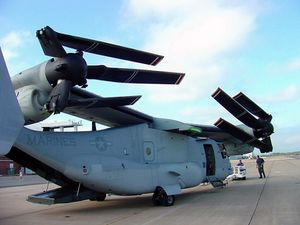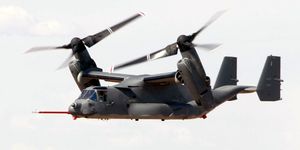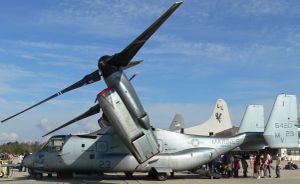PlaneSpottingWorld welcomes all new members! Please gives your ideas at the Terminal.
V-22 Osprey
| V-22 Osprey | |
|---|---|
| U.S. Marines jump from an Osprey. | |
| Type | VTOL transport |
| Manufacturer | Bell Helicopter Textron Boeing Helicopters |
| Maiden flight | 19 March 1989 |
| Introduced | 8 December 2005 |
| Primary users | United States Marine Corps United States Air Force |
| Developed from | Bell XV-15 |
The V-22 Osprey is a joint service, multimission, military tiltrotor aircraft with both a vertical takeoff and landing (VTOL) and short takeoff and landing capability (STOL). It is designed to perform missions like a conventional helicopter with the long-range, high-speed cruise performance of a turboprop aircraft. The initial operators are the U.S. Marine Corps and United States Air Force. The FAA classifies the Osprey as a model of powered lift aircraft.
Contents
Overview
The Osprey is the world's first production tiltrotor aircraft, with one three-bladed proprotor, turboprop engine, and transmission nacelle mounted on each wingtip. It typically operates as a helicopter with the nacelles vertical (rotors horizontal) for takeoff and landing. Once airborne, the nacelles rotate forward 90 degrees in as little as 12 seconds for horizontal flight, converting the V-22 to a high-speed, fuel-efficient turboprop airplane. STOL rolling-takeoff and landing capability is achieved by having the nacelles tilted forward up to 45 degrees. For compact storage aboard ship, the V-22's wing rotates to align, front-to-back, with the fuselage. The proprotors also fold in a sequence taking between 90 and 120 seconds.
History
Development
The V-22 is equipped with a glass cockpit, which incorporates four Multi-Function Displays (MFDs) and one shared Control Display Unit (CDU), allowing the pilots to display a variety of layers, including: digimaps centered or decentered on current position, FLIR imagery, primary flight instruments, navigation (TACAN, VOR, ILS, GPS, INS) and system status. The flight director panel of the Cockpit Management System(CMS) allows for fully-coupled (aka: autopilot) functions which will take the aircraft from forward flight into a 50' hover with no pilot interaction other than programming the system.
The aircraft was originally designed to be pressurized, but the rotating wing (for shipboard stowage) makes it difficult to properly seal the cabin. As a result, pilots and aircrew must wear oxygen masks while flying above 10,000 feet (3,000 m). The V-22 uses an on-board oxygen generating system (OBOGS) which draws compressed outside air from the turbine engines and separates out the oxygen and nitrogen. The nitrogen is used by the fuel cells to fill the ullage with inert gas as the JP-5 is consumed.
The V-22 is a fly-by-wire aircraft with triple redundant flight control systems. With the nacelles straight up in conversion mode (90 degrees), the flight computers command the aircraft to fly like a helicopter, with cyclic forces being applied to a conventional swashplate at the rotor hub. With the nacelles in airplane mode (0 degrees) the flaperons, rudder and elevator fly the aircraft like an airplane. This is a gradual transition which occurs over the entire 96 degree range of the nacelles. The lower the nacelles, the greater effect of the airplane-mode control surfaces.
The V-22 was developed and is built jointly by Bell Helicopter Textron, which manufactures and integrates the wing, nacelles, rotors, drive system, tail surfaces, and aft ramp, as well as integrates the Rolls-Royce engines; and Boeing Helicopters, which manufactures and integrates the fuselage, cockpit, avionics, and flight controls. Portions are manufactured in Philadelphia, Pennsylvania, Grand Prairie, Texas, and Fort Worth, Texas. Final assembly and delivery occurs in Amarillo, Texas. The joint development team is known as Bell-Boeing.
Testing
There have been four significant failures during testing:[1]
- On June 11 1991, a miswired flight control system led to two minor injuries when the left nacelle struck the ground while the plane was hovering 15 feet in the air, causing it to bounce and catch fire.
- On July 20 1992, a leaking gearbox led to a fire in the right nacelle, causing the plane to drop into the Potomac River in front of an audience of Congressmen and other government officials at Quantico, killing all seven crewmen and grounding the plane for 11 months. The seven crewmembers were Brian J. James (copilot), Sean P. Joyce (crew chief), Gary Leader (crew chief), Gerald W. Mayan (instrumentation engineer), Robert Rayburn (flight test engineer), Anthony J. Stecyk, Jr. (mechanic), and Patrick J. Sullivan (pilot). James, Joyce and Leader served in the US Marine Corps. Mayan, Rayburn, Stecyk and Sullivan were employees of The Boeing Company.
- On April 8 2000, two V-22s, loaded with Marines to simulate a rescue, attempted to land at Marana Northwest Regional Airport in Arizona. They descended unusually quickly from an unusually high altitude; the second V-22, descending at over 2,000 feet per minute (600 m per minute) with a forward speed of under 45 miles per hour, suddenly stalled in its right rotor at 245 feet, rolled over, crashed, and exploded, killing all nineteen on board. The official cause was determined to be vortex ring state (VRS), a fundamental limitation on vertical descent which is common to helicopters. At the time of the mishap, however, the V-22's flight operations rules restricted the Osprey to an 800 feet per minute (240 m/min) descent at lower than 40 knots (74 km/h) airspeed (restrictions typical of helicopters, as well); the crew of the aircraft in question exceeded this operating restriction threefold. Another factor that may have triggered VRS was their operating in close proximity, which is believed to be a risk factor for VRS in helicopters. The military says that subsequent testing has shown that the V-22, and the tiltrotor in general, is less susceptible to VRS; the conditions are easily recognized by the pilots; recovery from VRS requires a more natural action by the pilot than recovery in helicopters; the altitude loss is significantly less than for helicopters; and with sufficient altitude (2000 feet or more), VRS recovery is relatively easy.[1] They also claim recognition of and recovery from VRS is easily trainable for new pilots. As a result of testing, the V-22 will have a descent envelope as large or larger than most helicopters, further enhancing its ability to enter and depart hostile landing zones quickly and safely. The project team also dealt with the problem by adding a simultaneous warning light and voice that says "Sink Rate" when the V-22 approaches just half of the VRS-vulnerable descent rate.
- On December 11 2000, a hydraulic leak caused by a wiring bundle chafing and wearing through a hydraulic line crippled an engine; a previously undiscovered error in the aircraft's control software caused it to decelerate each time in response to the pilot's eight attempts to reset the software to compensate for the dead engine, and the plane fell 1,600 feet into a forest, killing all four aboard. The four marines aboard were Lt. Col Keith M. Sweaney, Maj. Michael L. Murphy, Staff Sgt. Avely W. Runnels, and Sgt. Jason A. Buyck. The wiring harnesses and hydraulic line routing in the nacelles has been modified.
The V-22 completed its final operational evaluation in June 2005. The evaluation was extremely successful; events included long range deployments, high altitude, desert and shipboard operations. It is claimed that problems identified in all of these mishaps have been addressed by the V-22 program office and advocates of the program are optimistic that the aircraft is mature enough for fleet operations.
Controversy
The V-22's development processes have been long and controversial. When the development budget, first set at $2.5 billion in 1986, had reached $30 billion in 1988,[citation needed] then-Defense Secretary Dick Cheney zeroed out the budget, but was overruled by Congress. The first flight occurred on March 19, 1989.
Critics claim that the aircraft will never be mature enough for fundamental design flaws and that the V-22 is inherently dangerous because of its flawed side-by-side rotor design. Extensive media coverage of accidents during its development resulted in public questioning of whether the fundamental premise of the aircraft might be fatally flawed.
Additionally, the V-22 squadron's former commander at New River, Lieutenant Colonel Odin Lieberman, reputedly instructed his unit that they needed to falsify maintenance records to make the plane appear more reliable. A crew member's recording included him stating that "We need to lie or manipulate the data, or however you wanna call it".[1]
Procurement
On September 28 2005, the Pentagon formally approved full-rate production for the V-22. The current plan is to boost production from 11 a year to 24 to 48 a year by 2012. Planned production quantities include 360 for the Marine Corps, 48 for the Navy, 50 for the Air Force. The U.S. Army, originally the lead service for the then-named JVX program, is also a candidate for possible applications.
On December 12 2005, the Pentagon announced that the procurement budget for the Marine Corps V-22s would be reduced by $1.1 billion over the production run. The plans for the Air Force were unaffected.
On July 8 2006, the Pentagon announced plans to buy two new V-22s within the 2007 military budget outlined by President George W. Bush and his cabinet.
Israel has shown interest in the purchase of an undisclosed number of MV-22s, but an official order has not been placed or approved.[2]
Variants
The Marine Corps is the lead service in the development of the V-22 Osprey. The Marine Corps variant, the MV-22B, will be an assault transport for troops, equipment and supplies, and will be capable of operating from ships or from expeditionary airfields ashore.
The CV-22, operated by the U.S. Special Operations Command (USSOCOM), will conduct long-range special operations missions, combat rescue, among other special missions. The V-22 Osprey will replace the Marine Corps CH-46E and CH-53D. The U.S. Air Force (which willl operate the USSOCOM aircraft) officially accepted the CV-22 on November 16, 2006 in a ceremony conducted at Hurlburt Field.
The planned, but as yet unfunded, U.S. Navy HV-22 will provide combat search and rescue, delivery and retrieval of special warfare teams along with fleet logistic support transport.
A growth variant being proposed by a joint Bell-Boeing team is a four-rotor version called the Bell Boeing Quad TiltRotor.
Service
On June 3, 2005, the Marine Corps helicopter squadron, HMM-263, stood down to begin the process of transitioning to the MV-22 Osprey. On December 8, 2005, Lieutenant General Amos, commander of the 2nd Marine Expeditionary Force, accepted the delivery of the first fleet of MV-22s, delivered to HMM-263. The unit reactivated March 3, 2006 as the first MV-22 squadron, and was re-designated VMM-263. The Osprey will enter operational service with the Marine Corps in 2007.
In the spring of 2006, a V-22 experienced an uncommanded engine acceleration while ground turning at MCAS New River. Since the aircraft regulates power turbine speed with blade pitch, the reaction caused the aircraft to go airborne with the Torque Control Lever (TCL, or throttle) at idle. It was later found that a mis-wired cannon plug to one of the engine's two Full Authority Digital Engine Controls (FADEC) was the cause. After the aircraft was airborne for approx 2 seconds, and 30 feet in the air, the second FADEC recognized the fault, took over, and made the engine speed match the TCL position—idle. The aircraft came back to the ground and one wing broke off, as it is designed to do, to absorb the impact. There were no serious injuries. Pilots now guard the controls during this point in the startup checklist in case of inadvertent flight, so that if the aircraft goes flying, they can keep it flying (push the TCL forward) until the FADEC switch over, then land it safely.[3] The FADEC software was also modified to decrease the amount of time needed for the switch between the redundant FADEC's - this deficiency correction eliminates the possibility of a similar mishap occurring in the future.
On July 11 2006 a V-22 experienced compressor stalls in its right engine in the middle of its first transatlantic flight to the United Kingdom for the Royal International Air Tattoo and Farnborough Air Show.[4] It had to be diverted to Iceland for maintenance. A week later it was announced that other V-22s had been having compressor surges and stalls and the Navy had launched an investigation into it. [5]
On February 10 2007 the Air Force and Marine Corps temporarily grounded their entire fleet after discovering a glitch in a computer chip that could cause the aircraft to lose control. [6]
The Marine Corps plans to use the V-22 in Iraq in 2007.[4]
Limitations
Because of the extreme downdraft of the propellers, Marines cannot rappel out the side doors as in the MH-60 series helicopters. Moreover, the engines would block the firing arc of side-mounted machine guns and so none can be fitted in these positions. As in the CH-47 and CH-53 series helicopters, Marines will use the rear ramp to exit and use the extended ramp to mount a machine gun firing out the rear.[5] A chin-mounted turret was initially proposed, but experience gained during Operation Enduring Freedom and the high cost of integration led to the adoption of the ramp mounted M240 machine gun solution.[6][7][8]
Specifications (V-22)
Data from Boeing Integrated Defense Systems[9] and Navy Air Systems Command[10]
General characteristics
- Crew: two pilots
- Capacity: 24 troops
- Length: 57 ft 4 in (17.5 m)
- Rotor diameter: 38 ft 0 in (11.6 m)
- Wingspan: 46 ft in ( m)
- Height: 17 ft 11 in (5.5 m)
- Disc area: 9,100 ft² (840 m²)
- Wing area: ft² ( m²)
- Empty weight: 33,140 lb (15,032 kg)
- Loaded weight: 47,500 lb (21,500 kg)
- Max takeoff weight: 60,500 lb (27,400 kg)
- Powerplant: 2× Rolls-Royce AE 1107C-Liberty turboshafts, 6,150 hp (4,590 kW) each
Performance
- Maximum speed: 275 knots (316 mph, 509 km/h)
- Cruise speed: 214 knots (246 mph, 396 km/h) at sea level
- Combat radius: 370 nm (430 mi, 690 km)
- Ferry range: 2,417 nm (2,781 mi, 4,476 km)
- Unrefueled range: 879 nm (1,011 mi, 1,627 km)
- Service ceiling: 26,000 ft (7,925 m)
- Rate of climb: 2,320 ft/min (11.8 m/s)
- Disc loading: 20.9 lb/ft² @ 47,500 lb GW (102.23 kg/m²)
- Power/mass: 0.259 hp/lb (427 W/kg)
Note the CV-22 differs in the following categories[7]
- crew=two pilots; two flight engineers
- capacity=24 troops (seated), 32 troops (floor loaded) or 10,000 pounds of cargo
- Wingspan: 84 ft 7in
- height main=22 ft 1 in
- max speed main=277 knots
References
- ↑ 1.0 1.1 1.2 Saving the Pentagon's Killer Chopper-Plane. Wired, July 2005.
- ↑ "Israel considers V-22 acquisition ." Ben-David, A. Jane's Defence Weekly. January 25 2006.
- ↑ White, Lance Cpl. Samuel D. (2006). VMM-263 ready to write next chapter in Osprey program. Marine Corps News. United States Marine Corps. Retrieved on 2006-04-10.
- ↑ "Set to Soar." Boeing Frontiers. July, 2006.
- ↑ White, Lance Cpl. Samuel D. (2006-08-22). VMX-22 puts M-240 to test on ‘Osprey’. Marine Corps News. Retrieved on 2006-10-04.
- ↑ [1]
- ↑ [2]
- ↑ [3]
- ↑ V-22 Osprey Technical Specifications. Boeing Integrated Defense Systems.
- ↑ …It's not Just Evolutionary, it's Revolutionary. Navy Air Systems Command.
External links
- Official site, Boeing.
- Discussion of V-22 VRS accident
- Series of articles critical of the safety of the V-22
- After decades of tragedy, Osprey may be ready for combat, Otto Kreisher, San Diego Tribune, July 15, 2005
- A video footage of the 1991 Osprey crash with commentary
- Dispelling the Myths of the MV-22
- Osprey OK'd
- Onward and Upward
- "Flight of the Osprey", U.S. Navy video of V-22 operations.
- VMM-263 ready to write next chapter in Osprey program
- Congressional Research Service Summary of V-22 Pros and Cons
- Review of political forces that helped shape V-22 program
- The Osprey finally soars - Jul 18, 2006
- The Osprey On FutureWeapons - Feb 2007
Related content
Related development
Designation sequence
Related lists
See also
Fighter aircraft: YFM-1 · P-39 · P-59 · P-63 · XP-77 · XP-83
Commercial Helicopters: 47 · 204 · 205 · 206 · 210 · 212 · 214 · 222 · 230 · 407 · 412 · 417 · 427 · 429 · 430
Military Helicopters: H-13 · UH-1 · 207 · 209 · AH-1 · 309 · YAH-63 · OH-58 · ARH-70
Tiltrotors: V-22 · BA609 · TR918 · QTR
Experimental aircraft: X-1 · X-2 · X-5 · X-20 X-22 · XV-3 · XV-15 · 533 ·
Lists relating to aviation | |
|---|---|
| General | Timeline of aviation · Aircraft · Aircraft manufacturers · Aircraft engines · Aircraft engine manufacturers · Airports · Airlines |
| Military | Air forces · Aircraft weapons · Missiles · Unmanned aerial vehicles (UAVs) · Experimental aircraft |
| Notable incidents and accidents | Military aviation · Airliners · General aviation · Famous aviation-related deaths |
| Records | Flight airspeed record · Flight distance record · Flight altitude record · Flight endurance record · Most produced aircraft |
da:V-22 Osprey de:Bell-Boeing V-22 fr:V-22 Osprey nl:V-22 Osprey ja:V-22 (航空機) no:Bell-Boeing V-22 Osprey pl:V-22 Osprey fi:V-22 Osprey sv:Bell/Boeing V-22 Osprey




